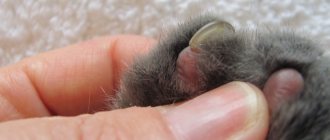How to tame a wild kitten
Future owners are worried: how to tame a kitten, what if the situation gets out of control and an unaffectionate cat will grow out of a cute creature. The baby quickly gets used to it and begins to understand:
- Where is the toilet.
- Where is the bowl of food?
- Who lives in the family, from whom you need to hide.
To tame a cat you will have to wait ten days (maximum). Usually this much time is spent on re-educating a street dweller.
It’s worth learning from the very beginning: a kitten’s squeak means “I feel bad,” while purring is a sign of goodwill and contentment.
There is no need to push a squeaking lump into a bathtub of water or allow children to cause pain. The kitten should feel safe and loved. It’s easy to accustom a kitten to handling and rules of behavior (both in the house and at an exhibition): affection, play and treats will do.
Once the baby is in the house, you need to give him time to calm down. You can leave him in an unlocked cage or put him in a low cat basket. Don't forget to place a bowl of water nearby.
In a calm environment, the kitten will soon crawl out of its shelter and go to inspect the territory of the house. Don't pick him up just yet. It is enough to gently stroke him and say a few words in a calm tone. Then transfer to a bowl and praise. In this case, the kitten in your hands will not perceive the action as danger.
Within 24 hours, the cat will begin to trust its owner and may jump onto its lap. The kitten will learn to sit quietly in your arms if you support it by its back. The warmth of the hand is soothing, and any possible fear of heights disappears.
Anticipate events
An example: the owner is going to train the kitten to use the litter box. To do this, he bought an expensive, comfortable and beautiful tray, poured filler into it and even held the kitten three times until the “victory end”.
And then the owner comes home from work, and all the waste products of the pet are anywhere but in the tray. What does the owner do? Of course he punishes. And this seems quite natural to people.
- But the kitten is not a person, and for him it looks completely different. He was waiting for the owner, sincerely rejoiced at his arrival, ran to meet him, and he, instead of scratching behind his ear, began to scream, grabbed him, and even punished him. Next time the baby will be afraid of the owner's arrival. And later it will become completely uncontrollable.
- But what should be done? Just create conditions under which the baby doesn’t want to do anything dirty. Is the sofa tearing up? Spray the furniture with a special product that repels cats with its smell.
- There are some on sale now. Humans cannot smell this smell, but cats find it unpleasant. This type of spray is used to wean moustaches from relieving themselves in the wrong place.
If you can’t find such a product on sale, you can always use a sprayer for home flowers. You see that the kitten has approached the sofa and is aiming to clean its claws, so spray water on it. If you do this every time, very soon the baby will understand that there is no need to do this.
Moreover, it is important to remember that you cannot break your rules. You can’t prohibit a kitten from climbing on the table today and give up on it tomorrow. It’s impossible today, which means it’s impossible always.
How to accustom a cat to hands and affection
If you want cat affection, become patient and affectionate yourself. An outdoor cat will begin to trust a person when it gets used to his smell and voice. He will associate his appearance with a pleasant event (food, affection).
A wild cat is tamed in the same way as a kitten. First, treats are brought regularly. Then they hold out their palm with a piece of the most delicious thing (the delicacy lies in the center of the palm, not on the fingers!), and allow it to be sniffed. When the cat begins to approach, perhaps rubs its head on its leg, you can pet it in response, speaking calmly and affectionately.
A common mistake: in order to tame a cat at home, he is immediately locked in a room - the animal will try to escape as soon as it is freed.
You can call the cat with you, after a few meters, stop, praise, and give a treat again. The main thing is that if you come, give her the opportunity to leave. Without feeling afraid, the pet will return.
How long will it take?
With the appearance of a pet, a person has many questions: how to train a kitten, how long will it take, will he go to the litter box? The most important of them is adaptation time. Even experienced animal psychologists (animal behavior specialists) cannot guarantee any clear framework. The addiction process can take several days or several months. It is important not to rush things and be patient. In general, it is believed that if the pet is about two months old, it will take a week to tame. The situation is more complicated with adult cats. Here it can take months to adapt, since it is difficult to introduce something new into the animal’s existing behavior.
Why is the cat not affectionate?
If a cat scratches and bites as an adult, the owners themselves are to blame. While still playing with her, they allowed her to “claw” in excitement. At first it's funny, then the adult:
- bites legs;
- does not allow himself to be combed;
- spoils things, marks territory.
The simplest veterinary examination and medical procedures (injections, enemas) turn into a nightmare for the owner.
The independence and aggressiveness of a mustachioed cohabitant should not be shown towards family members. If the owners are afraid, the pet will become impudent. It is recommended to hold the cat in your arms more often and show affection. After taming, release it for further exploration of the area, praise and treat it with something tasty for good behavior.
Gradually the cat will understand: nothing bad is happening. If you do this regularly, at the same time talk affectionately, give a piece of “yummy” - after a while you can add short-term combing, examining the ears and other manipulations.
An irrepressible desire to “cuddle” can also be the reason why a cat becomes less affectionate. Small children will happily play with the kitty and pull its ear or tail.
Adults sometimes don’t lag behind (especially if the cat is not their property): they shamelessly shove pieces from the table, try to stroke them and pick them up against their will. It's not the cat that needs to be blamed, but the owner:
- If the cat is not the highlight of the program, it is better to isolate it in another room. Or warn the guest about correct behavior.
- For children, it is better to find other fun, otherwise the simplest scratch on the hand of an uncontrollable child will ruin the evening.
- When neither the person nor the cat is particularly anxious, let them interact as they wish.
Advice. It is advisable to wash your hands not only after interacting with an animal, but also before. Precautionary measures apply to small unvaccinated kittens.
The selection of some breeds followed the path of consolidating external characteristics. Such cats are more attached to the territory than to the owner. For example, bobtails and Norwegian forest cats do not recognize excessive affection.
It is better to choose a Burmese, Siamese, Sphynx or Rex or an ordinary yard cat - a “mongrel”. “Human-dependent” cats can hardly tolerate loneliness, they are easy to tame and they love the affection of their owner.
Congenital features
By nature, every cat is a proud and affectionate animal, obeying its owner only for practical reasons. Innate egoism lies in the response to the actions of the “big brother”. If his behavior is hostile, the baby, and then the adult, will be withdrawn and aggressive.
Practicality is manifested in the fact that the kitten will never perform manipulations that do not benefit it. Therefore, one of the methods of education is to portray any negative action in an unfavorable, useless light. Then it’s worth showing another, more attractive pastime.
The rules of upbringing and training were developed over the years of close attention to representatives of the furry kingdom. Here are the results of many years of work:
- Educational activities are initiated from the first day of joint stay in the apartment/house.
- Do not encourage the kitten's familiar attitude, show that you are the master of the situation here and demand that certain rules be followed.
- Taboo on aggressive behavior and the use of brute physical force.
- Do not intimidate your pet with loud screams or sudden movements of the limbs.
- A proud pet will not tolerate humiliation. If you poked your nose into his puddle, this will cause an outbreak of resentment and vendetta in the future.
- A kind attitude will help raise a kitten to be affectionate and tame.
- The cat's perception acutely senses your emotional state and voice accompaniment. Therefore, to indicate an error, a sharp “chopped” phrase is enough: “You can’t!”, “No!”, “Scram!”
- The mental abilities of cats are at a high level, but acquiring skills, habits and abilities will take time and effort.
Is it possible to tame an adult cat to a new owner?
A cat tolerates a change of owner more easily than a dog. The exception is socially oriented breeds, for example, Oriental Siamese. They will gradually become affectionate with their new owners, but the first one is the only one for life.
The best way to train, even for a sexually mature individual, is not food, but play. First, an adult cat must get used to the territory. It is better to leave your pet to explore its new home on its own, and after a while offer some food from your hands. Just like a treat. At the same time, do not forget to talk measuredly, but not to stroke.
As soon as the cat gets used to it a little, you can:
- lightly scratch a chair or furniture - so that the cat reacts to the sound near the owner;
- roll a ball or ball of wool near you, inviting you to play;
- “drive” a candy wrapper.
The cat quickly joins the game. After a while, you should again give a piece of food from your hand and praise it.
A few rules of communication
There is no single answer to the question of how to tame a wild kitten at home. For each animal you need to come up with and try different approaches. There are several general recommendations for adaptation of wild animals. Remember that the normal instinct of an outdoor cat is to be afraid and bite as a defense. Therefore, in the first days, do not try to forcefully pet the kitten. Give him time to adapt. Try to talk kindly and gently with your pet - this will be enough for the first time. Get ready for the fact that the solution to the question of how to train a cat to use a litter box may take a long time. This also applies to learning to use a scratching post, feeding from a bowl, and much more. Act gradually, be patient, and eventually you will achieve your goal!
Reasons for behavior change
If a previously affectionate cat has stopped making contact with her owner or has become aggressive, then most likely something is bothering her. The most common reasons for changes in animal behavior :
- disease;
- puberty;
- stress;
- poor care;
- age.
© shutterstock
If you correctly understand the cause and eliminate it, the cat will become habitually affectionate.
The cat is sick
Poor health greatly affects the character of the pet. A sick cat, who only yesterday loved affection, today may hide from its owner or even attack him. By its behavior, the animal shows that something is bothering it.
Show the animal to the cat doctor - veterinarian. After examination and examination, he will be able to determine whether the animal is healthy and, if necessary, prescribe treatment. Follow all the recommendations and your pet will quickly recover. After a complete recovery, the pet will be the same as it was before the illness.
The kitten has grown up
The kitten grows up and, under the influence of hormones, its character begins to change. Marks appear in the house, and the animal may even try to escape in search of a member of the opposite sex. Often the cat becomes aggressive and may scratch or bite the owner. Behavior does not depend on whether the animal is allowed outside or not. Some owners believe that if they take the cat to mating, he will become calmer, but this is fundamentally wrong, the situation will only get worse.
The only solution is castration. After the operation, the cat will become as affectionate as before . The animal will be calmer and will happily begin to spend time with its owner.
Stress
In an unfamiliar environment, the animal behaves warily and sometimes aggressively. Moving to a new home or acquiring a new pet disrupts the cat’s usual way of life. Also, your pets will not be happy about vacation trips or moving to the garden for the summer.
© shutterstock
After adaptation, which lasts about 3 weeks, the cat will become affectionate again. In order to facilitate this process, you can give your pet calming tablets, which are sold in pet stores. Most likely, the cat will not be affectionate until the adaptation is complete.
Poor animal care
Poor grooming of a cat can make it unkind. A hungry animal becomes irritable. Therefore, it is important to give the animal high-quality, healthy food that contains all the necessary vitamins and microelements. A dirty litter box can also irritate your cat, so either clean the litter box immediately after use or buy an absorbent litter.
The animal must not be beaten or shouted at. A frightened cat will not be affectionate because it is afraid of its owner. Communication should be friendly, pamper the animal with treats more often and play with it. A satisfied cat will be affectionate with its owner and will enjoy spending time with him.
Restricted areas
If your pet comes up to you to rub against your legs, do not yank him to pick him up. Remember, cats do not like to be deprived of their freedom and treated like a doll. Just gently call the cat to your sofa for petting. If she wants, she will come, and then you can caress her. But not all places on a cat’s body crave these caresses. There are areas, touching which alarms the animal and instinctively provokes it into aggression or escape. These areas include:
It is best to observe the cat’s reaction to your touch; over time, you yourself will understand which places it is better not to touch, and in which areas it is better to double the portion of strokes.
Ways to train a kitten
Sometimes you can’t just calmly sit a kitten in your arms, because it gets scared and, even when it recognizes the person, continues to struggle. In order for a pet to be willingly given into the owner’s hands, it is necessary to accustom it to this, if it itself does not show a desire to actively make contact. As soon as the kitten realizes that communicating with the owner, when he takes him in his hands, brings him pleasure, the baby himself will strive to cuddle the person. Be sure to hold the kitten correctly, caress the pet and talk calmly to it. It’s very good if the cat starts playing while in your arms.
The kitten will quickly stop being afraid to be handled if you use one of the training methods below.
- Using the characteristics of animal physiology. After the kitten has eaten well, it begins to feel sleepy, since maximum energy is spent on digesting food. If the animal is warm and comfortable at this moment, it will begin to experience special pleasure. The owner may well provide the pet with the illusion that he is lying next to his mother if he picks up a well-fed, dozing kitten and cuddles him, but without squeezing. Gradually, the baby will get used to the fact that sitting in your arms is very pleasant and safe.
- Talk. Monotonous, affectionate conversation with the kitten gradually begins to relax it. At this moment, the owner has the opportunity to gently stroke the pet behind the ear or in the throat area. If the kitten reacted calmly to such affection, you need to place your palms on its sides. If the baby does not break free here, he is carefully picked up. When the kitten tries to escape, you should not restrain it by force. Such sessions must be repeated several times a day, until the baby agrees to stay on the owner’s lap.
- Lure with a treat. This method is most suitable for kittens who are particularly freedom-loving and cannot combine being held in their arms with pleasant sensations. Using a treat, the owner lures the pet onto his lap. While the kitten is eating the treat, you need to stroke it on the back, but under no circumstances hold it by force. Gradually, the baby will get used to the fact that it is pleasant to be held and will actively seek the company of the owner.
- Overcoming the fear of heights. As strange as it may sound, some cats are terrified of heights. Because of this, when a kitten is picked up incorrectly and he perceives what is happening as floating in the air, he experiences a severe shock. This phenomenon can be prevented simply by starting to hold the baby correctly. Then his fear of hands will go away. You need to take the kitten with one hand under the armpits, and place the other under its hind legs. After this, the baby should be held close to you, but not squeezed. If the fear is panicky, then first you need to accustom the kitten to your hands while sitting on the floor.
- Training in the game. This method is suitable for active kittens who are not yet ready to exchange free time for affection. When playing with such a baby with a toy, you should gradually pull it onto your lap. After the kitten jumps into your arms, you need to let him catch the toy here and enjoy the catch. While the kitten is playing in your arms, you can pet it. Gradually, such games with jumping into hands will lead to the fact that the animal will not only completely get used to the hands, but will not be able to do without affection and close contact with a person. With this nature of the pet, you should often allow the cat to sit in your arms while playing with the owner.
The choice of method depends on the individual characteristics of the kitten, and each owner must evaluate for himself which method is optimal in his case. In principle, accustoming a kitten to affection cannot fail, you just don’t need to stubbornly follow a method that is not suitable, but need to be creative in your approach.











